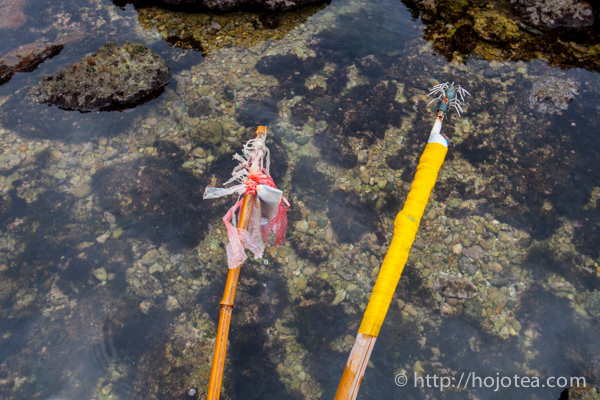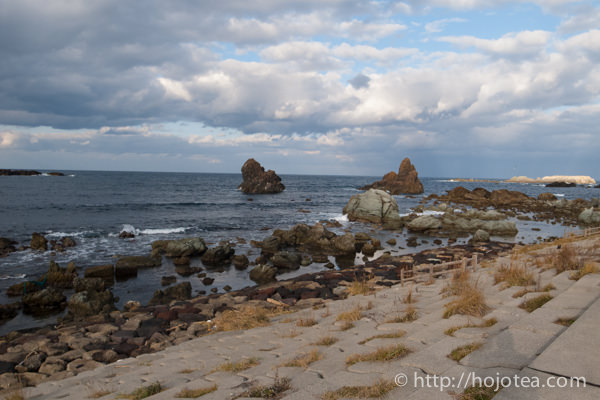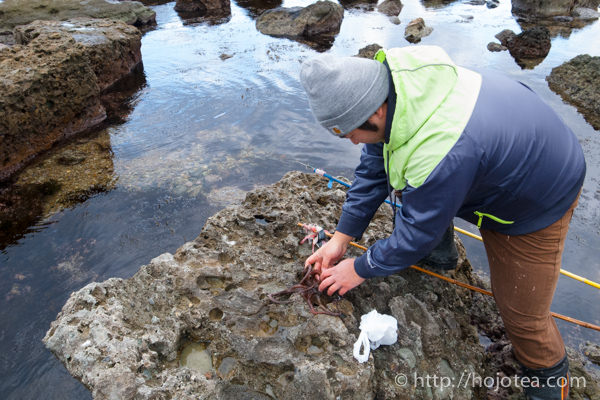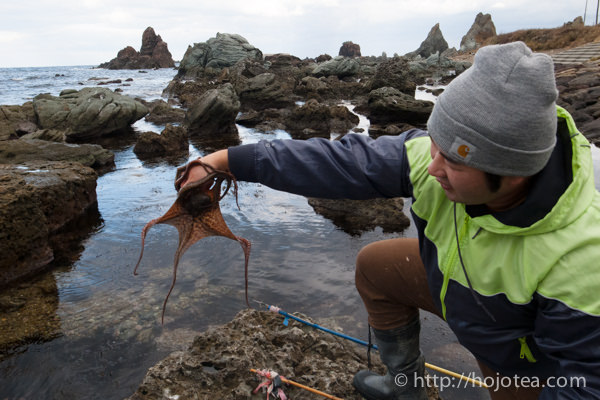- HOME >
- Tea Column
Visiting Sado Island in Winter
- [2013.12.23] Posted By Akira Hojo

I visited Sado Island to meet our potters, Watanabe Tozo and Shimizu Ken. This Island is situated in the north of Niigata prefecture where it was formed by submarine volcanos. For me, to get to Sado Island is like travelling overseas because it takes me 6 hours from my hometown, travelling by car and also ferry to reach the island. My first destination will be to get to Niigata prefecture, where there are 3 ports named Naoetsu, Akadomari and Niigata that leads to the Sado Island. Each day, there will only be 1-2 ferries available for transport to the island and it takes about 2-3 hours to reach.
During winter, the Japan Ocean turns very wild and unstable and the waves often rise up to 6m high. On the day when I travelled, it was a little stormy too and the height of the waves was up to 4m high; I felt like staying at the bottom of the laundry when I was on the ferry.
When the winter season sets in, there are obviously less tourists that visit the Sado Island. But on the contrary, it is the best season of the year to indulge in fine seafoods on this island. Due to the stormy condition of Japan’s Ocean during this season, many fishes evacuate to the bay of Sado Island. These fishes ingest on planktons existing in the ocean containing very high mineral content. It is due to the Osado and Kosado mountain that contains abundant in iron. Minerals flows into ocean through the river; hence, undoubtedly the fishes and other sea creatures in this island have very thick savour.
The Sado Island is also famous for its agricultural products of mushrooms, persimmons, pears, apples and bamboo shoots. With the same reason that seafood is tasty in Sado Island, their agricultural products also produces very rich taste due to the abundance of iron in their soil.
One of the mornings, I had a wondrous opportunity to accompany the son of the owner who runs the Inn to catch octopus. In Japan, we eat octopus in many styles, such as sashimi, sushi, deep fried and in salads. I have heard countless sayings that native octopus in Sado Island are very tasty. Fortunately for them who live in Sado Island, there is no need for them to buy octopus from shops; they are simply able to catch it at the beach whenever they need. The catching method was pretty simple as all we needed was two bamboo sticks. First, we attached colourful dangling strings on one of the stick and a sharp hook on the other stick. Then, the colourful strings were jiggled after being placed at the tide pool in front of the rocks. This was done to lure the hiding octopus out from beneath the rocks. I was all-out in learning and following the local people’s tactics and kept dangling the strings one after another in front of the rocks. Suddenly, an octopus emerged out from its hiding zone and startled me; I kinda panicked as I had not learn how to catch it. Well, I considered it beginner’s luck as I caught eye on an octopus earlier than the local experts. Thus, with the excitement, I tried to hook the octopus, but it kept missing my hook. I wondered if it would be possible to catch the stricken octopus; however, the octopus was voracious enough that it kept on and on despite the scratches made by my hook to its tender flesh so many times. Finally, I managed to seize one, and it became my sashimi meal. The octopus in Sado Island was indeed very tasty and unforgettable.
Way back during the ancient times, this Sado Island was formed by the submarine volcanoes bring about mountains that are very rich in iron on this island. The abundance of the iron is also distributed among the clays, agricultural products, not leaving out the sea creatures. My stay on Sado Island and having the luxury to taste its flavorsome local food, I was able experience the analogy between our body and minerals.
Related Articles
How to get the latest update on HOJO?
1. Follow Twitter, 2. Click "Like" on Facebook, and 3. Subscribe in newsletter. You can have the latest tea news from HOJO.
 Subscribe the Newsletter to enjoy the privileges
Subscribe the Newsletter to enjoy the privileges- You may receive a free sample upon purchase, or you may have the priority to purchase special products. So please remember to subscribe our newsletter as well as the social network.
- Myanmar White Tea Bud 2013 from Guo Gan, Myanmar
- We have released a raw Pu-erh tea, 緬甸白芽茶 2013 (Myanmar White Tea Bud 2013), produced by ethnic minorities in t …
- Yong De Wild White Tea 2025 Loose Leaf Limited Release
- We have released Yong De Wild White Tea Loose 2025. For the 2025 harvest, only the loose-leaf type was …
NEW ARTICLES
 Myanmar White Tea Bud 2013 from Guo Gan, Myanmar
Myanmar White Tea Bud 2013 from Guo Gan, Myanmar- We have released a raw Pu-erh tea, 緬甸白芽茶 2013 (Myanmar White Tea Bud 2013), produced by ethnic minorities in t …
 Yong De Wild White Tea 2025 Loose Leaf Limited Release
Yong De Wild White Tea 2025 Loose Leaf Limited Release- We have released Yong De Wild White Tea Loose 2025. For the 2025 harvest, only the loose-leaf type was …
 Experience the True Freshness of Raw Pu-erh : Tang Jia 2025 Loose Leaf Release
Experience the True Freshness of Raw Pu-erh : Tang Jia 2025 Loose Leaf Release- We have released Tang Jia Raw Pu-erh Tea 唐家古樹生茶 2025 Loose Leaf. Among HOJO’s raw pu-erh teas, Tang Jia Raw Pu …
 Yunnan Chun Jian Green Tea from High Mountain Gardens
Yunnan Chun Jian Green Tea from High Mountain Gardens- Yunnan Chun Jian Green Tea is now available. This tea is made from naturally grown leaves harvested from high …
 Limited Loose Leaf Release of 2025 Da Xue Shan Wild Raw Pu-erh Tea
Limited Loose Leaf Release of 2025 Da Xue Shan Wild Raw Pu-erh Tea- We have released the 2025 loose-leaf version of Da Xue Shan Wild Raw Pu-erh Tea. This tea comes from wild tea …
 Discover a New Way to Enjoy Tea: Cooking Rice with Tea
Discover a New Way to Enjoy Tea: Cooking Rice with Tea- Cooking rice with tea is a simple idea, but it brings surprisingly satisfying results. The tea’s flavour seeps …
 2025 Da Xue Shan Wild White Tea Now Available from Yunnan
2025 Da Xue Shan Wild White Tea Now Available from Yunnan- The 2025 harvest of Da Xue Shan Wild White Tea is now available. Crafted from truly wild Camellia taliensis tr …
 Fresh 2025 Yunnan White Tea – Select Your Favourite Lot Before Blending
Fresh 2025 Yunnan White Tea – Select Your Favourite Lot Before Blending- Freshly crafted in Yunnan and just arrived in KL, our new 2025 white tea is now available at our Gardens Mall …
 2024 Dong Shan Raw Pu-erh Tea – Crafted with the Producer for Desired Quality
2024 Dong Shan Raw Pu-erh Tea – Crafted with the Producer for Desired Quality- We have released the 2024 cake of Dong Shan Raw Pu-erh Tea. Earlier, we offered the loose-leaf version from th …
 Development of Firewood Roasted Hojicha Using Naturally Grown Tea from Yunnan
Development of Firewood Roasted Hojicha Using Naturally Grown Tea from Yunnan- We are currently staying in Yunnan Province for tea production. As the season nears its end, tea trees with pa …
Category
- New Arrival at HOJO Online Shop
- Featured Articles
- Newsletter
- Types of Tea
- Origin of Tea
- Teapot and Tea Equipment
-
Tea Column
- How to enjoy tea
- Tea Processing
- How to choose quality tea
- Tea constituents and functional effect
- Safety of Tea
- Foods
- Tea Business Operation
- Hobby and Outdoor Activity
- Ranking of Tea
- Video
- FAQ
- Media Release
Profile

- AKIRA HOJO
- I invite you to experience my tea selections.I was born in Nagano, Japan. In university, I studied agricultural chemistry, and I have the master degree in food science. I worked in Japanese food industry for 10 years. I involved in R&D, QC and QA. As a factory manager, I implemented ISO9000 series and managed the factory.
- The Art of Tea Magazine
- We posted the article on “The Art of Tea Magazine No.9, the magazine is published in Taiwan. We featured …
- New Straits Times
- The Malaysian National Newspaper, New Straits Times featured HOJO Tea on 17-Oct-2007.
Shop Info

Address:Lot No. T-215, 3rd Floor, The Gardens Mall, Mid Valley City, Lingkaran Syed Putra, 59200 Kuala Lumpur
Tel: +603-2287-4537
Business Hour: 10am to 10pm



















